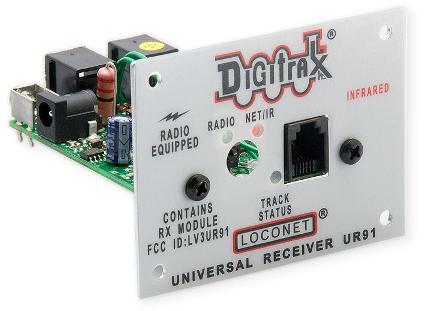
Here at the Tech Support Depot, it has been our goal to improve operators' understanding of the Digitrax system of model railroad command control.
We often see thoughtful words from others who are not employed by Digitrax that still have an in-depth understanding of the product line.
Here, Doug Stuard talks about the UR91; these words originally appeared on the Yahoo Groups Digitrax discussion list, and are used here with his kind permission.
UR91 and Throttle Antenna
The UR91 antenna is the pair of 3" wires that sprout from the PC board that are arranged in a "V" similar to rabbit ears.
In Digitrax radio throttles [DT400R & UT4R, ed.], the antenna is a copper trace on the PC board inside the throttle.
The modular cable on the throttle is NOT involved in any way.
The only reason it is mentioned in conjunction with radio operation is that it was part of the throttle configuration that was tested for FCC compliance.
Any changes technically invalidate the compliance, even if there is no actual connection.
LocoNet ID's
LocoNet IDs serve to separate LocoNet traffic between multiple wireless LocoNets [such as at train shows, ed.], and are thus maintained in both the UR91 and the infrared UR90.
The ID in the UR serves as a sort of "gate keeper", only passing packets from throttles with like ID, so there is no need for the command station to be involved.
Because UR91 and UR90 are receivers only, they have no way of knowing if another layout is nearby, so it is up to the user to change the LocoNet ID from the default value using a plug-in throttle.
Once set, all wireless throttles adopt the LocoNet ID for the network they were most recently plugged into.
If there is no UR on a given layout, then all operation is tethered (i.e., it is a closed system) and there is no need for a LocoNet ID.
Multiple UR91's
As to multiple UR91's, I haven't monitored LocoNet in such cases, but I would assume that either both URs would put the same data on the LocoNet simultaneously (no problem), or if not they could interfere with one another and re-send with randomized back-offs per the LocoNet CSMA-CD protocol.
Either way, the data gets through.
Loss of Control
Concerning loss of control, recent posts have pointed to the "power save" option on the DT400 as a possible source of trouble, prompting some to disable the option with good effect (but I could be wrong, Grin). Doug Stuard